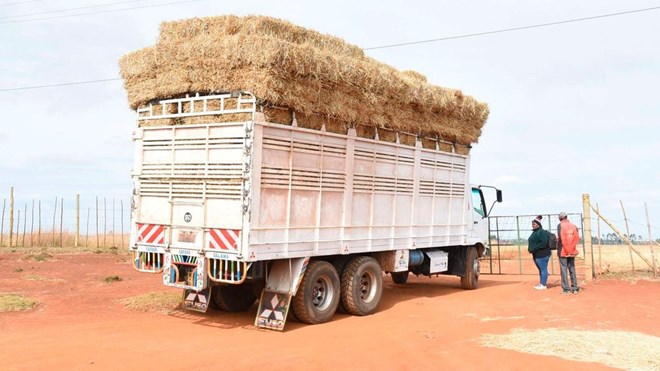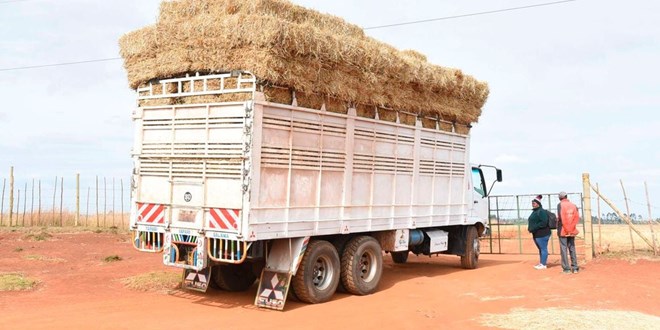[ad_1]

Sunday February 25, 2024

Across the continent, animal feed and fodder is in short supply. Kenya, for example, has a 60 percent animal feed deficit. PHOTO | NMG
Kenya, Uganda and Somalia are among six countries to pilot a programme to plug persistent shortage of animal feed and fodder.
Under the programme dubbed “Resilient African feed and fodder systems (RAFFS),” researchers want to improve livestock production and, by extension, nutrition.
“The lack and poor quality of feed is a driver of production inefficiencies translated into the high cost of livestock sourced foods unaffordable for those that need the nutrients most,” African Union-InterAfrican Bureau for Animal Resource’s (AU-IBAR) Dr Sarah Ashanut Ossiya said.
According to Josefa Sacko, the African Union Commissioner for Agriculture, Rural Development, Blue Economy and Sustainable Environment, this inefficiency is “further exacerbated by over 40 percent wastage of existing feed resources. The recent triple global crises of climate change, drought and flooding, Covid-19 and conflict in Russia – Ukraine and other conflicts have severely exposed the vulnerabilities in African feed and fodder systems.”
“The recent drought in the Greater Horn of Africa region resulted in a massive loss of over 9.5 million livestock, valued at over $2 billion,” she added.
Other losses are invaluable livestock genetic resources developed over decades, serving as a key factor for livelihoods and incomes, especially for pastoralists and smallholders who contribute over 80 percent of meat and milk production in the region.
“Subsequently, Africa imports about $4 billion worth of livestock sourced foods annually, effectively exporting millions of lucrative youth jobs,” added Sacko.
Researchers at the launch in Nairobi pointed to a gap in linking feed to human nutrition.
In Eastern Africa, for example, demand for livestock products is expected to grow at least three percent for all meats and more than six percent for eggs annually for the coming decade. Currently, most countries in eastern Africa consume one-third of the recommended amounts of animal source foods.
“Animal nutrition programmes should be supported by genetic improvement and robust animal health programmes,” said Uganda’s Minister of State for Agriculture, Animal Industry and Fisheries Rwamiraria Bright Kanyontore.
Interventions
“We need deliberate strategic interventions not just in animal nutrition, but also in animal breeding, and animal health to realise the desired efficiency in our production systems,” said Kanyontore.
Each of the six countries – others are Zimbabwe, Nigeria and Camroon – has a woeful tale of deficit and losses.
Kenya, according to the Cabinet Secretary for Agriculture and Livestock Development Mithika Linturi, is grappling with a 60 percent feed deficit of the total annual livestock feed demand of 55 million metric tonnes annually. Furthermore, it faces a 46 percent post-harvest loss.
Across the border, Uganda has a feed deficit estimated at between 50 percent and 70 percent. Somalia is suffering from its third consecutive below-average rainfall season since late 2020 that resulted in excess losses and below-average milk production.
In Nigeria, high production costs, especially in poultry and aquaculture, pose a significant challenge. Ruminants, the majority of Nigeria’s livestock, rely on communal grazing and crop residues, but these suffer from scarcity and security.
The Zimbabwean livestock sector has a cereal livestock requirement of 450 000 metric tonnes which is hardly met due to mid-rain season droughts, and shortage of inputs like seed, fertiliser and herbicides.
In Cameroon, animal feed import is projected to increase by 2.7 percent year-on-year, reaching 15.7 million kilogrammes in 2026. Since 2000, demand for animal feed in Cameroon has grown at an average of 4.7 percent year-on-year.
The RAFFS is funded by the African Union Commission and the Bill and Melinda Gates Foundation, and aims to address the adverse effects of Covid-19, climate shocks, and the conflict between Ukraine and Russia, on African feed and fodder systems.
Uganda and Somalia are among six countries chosen for a pilot programme to plug persistent shortage of animal feed and fodder.
“The lack of and poor quality of feed is a driver of production inefficiencies translated into the high cost of livestock sourced foods unaffordable for those that need the nutrients most,” African Union-Inter African Bureau for Animal Resource’s (AU-IBAR) Dr Sarah Ashanut Ossiya said.
“Animal nutrition programmes should be supported by genetic improvement and robust animal health programmes,” said Uganda’s Minister of State for Agriculture, Animal Industry and fisheries Rwamiraria Bright Kanyontore.
“To inform our next course of action we need deliberate strategic interventions not just in animal nutrition, but also in animal breeding, and animal health to realize the desired efficiency in our production systems,” said Kanyontore.
The conflict between Russia and Ukraine has had significant implications, adversely affecting food supply chains, leading to disruptions in production, sourcing, manufacturing and processing. This disruption has directly impacted the supply of wheat, soybean, and maize — crucial materials for animal feed.
According to researchers at the launch, there is a noticeable gap in linking feed and human nutrition.
In Eastern Africa only, it is projected that demand for livestock products is expected to grow at least three percent for all meats and more than six percent for eggs annually for the coming decade. Currently, most countries in Eastern Africa consume one-third of the recommended amounts of animal source foods.
Country survey reports, along with urgent actions endorsed by the Specialised technical committee, will be submitted to the African Union Heads of State and Government this year.
These documents will contain obligatory actions for African Union Member States to undertake in developing Africa’s Feed and Fodder sub-sector.
“This inefficiency is further exacerbated by over 40 percent wastage of existing feed resources. The recent triple global crises of climate change, drought and flooding, covid-19 and conflict in Russia – Ukraine and other conflicts have severely exposed the vulnerabilities in African feed and fodder systems.”
“The recent drought in the Greater Horn of Africa region resulted in a massive loss of over 9.5 million livestock, valued at over US$2 billion,” Josefa Sacko Commissioner for Agriculture, Rural Development, Blue Economy and Sustainable Environment.
She said the loss impacted even downstream actors with many processing units closed.
Other losses include invaluable livestock genetic resources developed over decades, serving as a key factor for livelihoods and incomes, especially for pastoralists and smallholders who contribute over 80 percent of meat and milk production in the region.
“Subsequently, Africa imports about $4 billion worth of livestock sourced foods annually, effectively exporting millions of lucrative youth jobs,” added Sacko.
The RAFFS is jointly funded by the African Union Commission (AUC) and the Bill and Melinda Gates Foundation, and aims to address the adverse effects of the recent global triple C crises, Covid-19, climate shocks, and the conflict between Ukraine and Russia, on African feed and fodder systems.
[ad_2]
